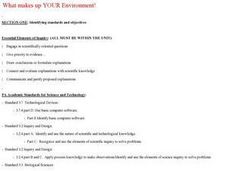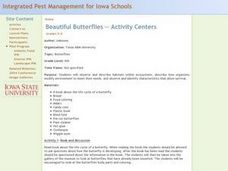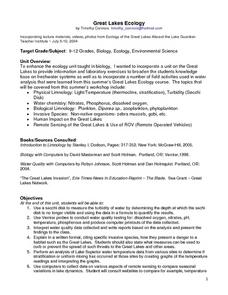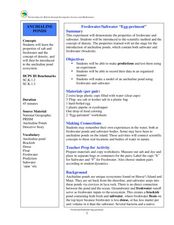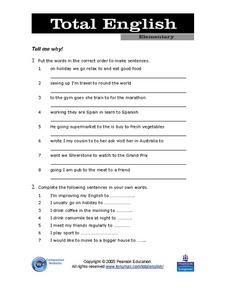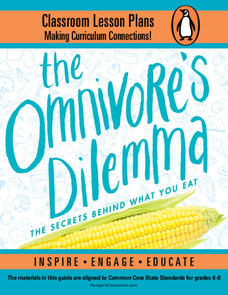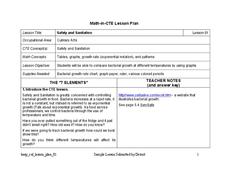Curated OER
Marine & Aquatic Habitats Activities - Aquatic Animals
Learners explore importance of marine or aquatic habitats, and investigate habitat characteristics and conditions required by various organisms to ensure survival. They then select an animal to study and design an artificial habitat...
Curated OER
Environmental Health Hazards and Children
Students are introduced to the environmental hazards their community is facing. In groups, they develop a list of the ways humans have changed the Earth and how these changes have lead to environmental hazards. They record their...
Curated OER
Plants, Animals and Our Environment
Students draw and label the basic needs of animals. They draw and label the basic needs of plants. Students understand the basic needs of plants and animals are not only the same, but are interrelated. They know that the environment...
Curated OER
What makes up YOUR Environment!
Students create their own land or water environment. They make their environment livable for all the different animals they collect to put in it. Students research the types of animals that they can have in their environment, and how...
Curated OER
Calling All Fruits And Vegetables!
Students differentiate between fruits and vegetables. They identify 20-25 common fruits and vegetables and utilize the Internet to gather and organize information about fruits and vegetables. Afterward, they create a new fruit and...
Curated OER
Dinosaurs
Students participate in a simulated archeological dig to gain an understanding of the earth's development as well as the organisms on it. In this dinosaur lesson plan, students work in small groups removing five pieces from the 'dig' one...
Curated OER
Beautiful Butterflies - Activity Centers
Students describe habitats within ecosystems, describe how organisms modify environment to meet their needs, and identify characteristics for butterfly survival. In this butterfly lesson plan, students explore all aspects of the...
Curated OER
Structural and Behavioral Adaptations
Students participate in a role playing lab that allows students to experience how different beak adaptations play a role in the type of food the animal can eat, therefore playing a role in the survival of the species.
Curated OER
Great Lakes Ecology
Eighth graders identify the Great Lakes, and describe the habitat of life of a loon. They are able to point to and explain one of the major river systems that enters the Great Lakes with a focus on the Clinton River and the food webs...
Curated OER
Life Systems - Plant Growth
3rd graders will participate in a variety of tasks which help them to understand the basic concepts of plant growth. Research and reporting skills are developed as they gather information from various sources related to the use of plants...
Curated OER
Lesson 1: Identifying Information
Factual books about animals are great for sparking interest in non-fiction text. Little ones will love learning about the foods animals eat as they practice identifying facts in a text. They chart the information they've learned by...
Curated OER
Freshwater/Saltwater "Eggs-Periment"
Students explore water properties by conducting a class experiment. In this buoyancy lesson, students utilize freshwater, saltwater, plastic cups, hard boiled eggs and food coloring to experiment with the floating capabilities of salt...
Curated OER
Reviving Celery
The classic in-class demonstration using celery dipped into water with food coloring is the highlight of this biology lesson plan. Young scientists discover that organisms are made up cells and have distinguishing characteristics. After...
Curated OER
Monthly Cost of Living Grocery List
In this economics worksheet, 4th graders find the cost of grocery items and compute the total cost per month for buying them in the graphic organizer.
Curated OER
Is it Alive?
Students watch a demonstration using Duco glue and water and try to determine if the "monster" shown is alive. After the demonstration, they discuss what characteristics make an organism "alive". They participate in a card sorting...
Curated OER
What Can We Do to Help End Hunger?
Students explore the problem of hunger and malnutrition. After discussing heroes, students select and describe those who worked against poverty or hunger to make a positive difference. An opportunity is given for students to participate...
Curated OER
Sentence Order: "Tell Me Why!"
In this sentence order worksheet, students rearrange words to correctly put sentences together. Then they complete sentences in their own words. There are sixteen questions to complete.
Virginia Department of Education
Go with the Flow
How does nature's hierarchy relate to our local human environment? Answer this question, along with others, as the class visually depicts the natural hierarchy provided by nature. Pupils discuss each piece of the pyramid and its energy...
University of Kentucky
Beneficial Bug Scavenger Hunt
Many people think of bugs as annoying pests to be squashed, but most insects and spiders are beneficial, eating the actual pests or pollinating plants. After reviewing some of the common bugs in your area (they may differ from those...
EngageNY
Experiments and the Role of Random Assignment
Time to experiment with mathematics! Learners study experimental design and how randomization applies. They emphasize the difference between random selection and random assignment and how both are important to the validation of the...
Penguin Books
The Omnivore’s Dilemma, Young Readers Edition
As the saying goes, you are what you eat. A useful set of lesson plans encourage young readers to take a second look at their eating habits. Pre- and post-reading questions bring in reflective writing and discussion while extension...
Virginia Department of Education
The Germ Theory and Koch’s Postulates
Explore the history of cholera and its effect on society with your biology class. Young biologists will then proceed to grow their own germs, prepared from live cultures, and follow the steps of the scientific method to generate data....
Social Media Toolbox
Reporting with Social Media
What does it take to create news stories that are both informative and objective? Aspiring journalists walk the line between engagement and activism with lesson 15 of a 16-part series titled The Social Media Toolbox. Grouped pupils...
National Research Center for Career and Technical Education
Safety and Sanitation
Your microbiologists explore the graphing of exponential growth functions using bacteria, like e. coli and salmonella, in a well-written, career and technology lesson.
Other popular searches
- Con Pair Organic Foods
- Organic Foods Taste
- Non Organic Foods
- Com Pair Organic Foods
- California Organic Foods
- Compair Organic Foods
- Conpair Organic Foods
- Organic Foods Lesson Plan



